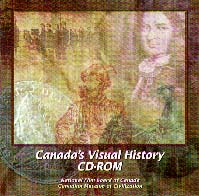|
________________
CM . . . .
Volume V Number 4 . . . . October 16, 1998
Canada's Visual History CD-ROM consists of eighty volumes, each
containing an historical essay written by a specialist on the
topic. Each topic is accompanied by thirty images which have
been selected from among the best heritage collections across the
country. Following each essay is a list of suggestions for
further reading on the topic. The volumes deal primarily
with Canada's social history, and, in many cases, have a regional
or local focus. As such, they tend to be more specific than most
elementary or junior high school students would need in order to
do the sort of broad research assignment they are given in social
studies classes. However, many essays have information relevant
to such topics, and, if sufficient guidance is given by a teacher
or librarian on how to handle this CD, valuable nuggets may be
ferreted out by patient and persistent students.
Each text, written by active historians, researchers and
teachers, provides good quantity, in-depth information about the
subject. Unfortunately, for elementary students, the reading
level of these essays is well into the grade 7 and above range.
Although the unique assembly of photos, rare paintings and
drawings, original charts and maps accompanying each essay has
great potential for expanding students' understanding, a high
level of reading and skimming ability is necessary for these
images to be of real value to the researcher.
The main menu screen is divided into four sections: Themes,
Volumes, Index and Search. "Themes" lists essays by cities,
native populations, immigration and colonization, arts and
crafts, social and political development, industry, conflict and
resource exploitation. Clickable under each theme are essays,
images, suggested readings and a glossary. Selected images and
text may be copied, saved or printed through an integrated word
processor available by clicking an on-screen command. This
section is probably the most useful for student researchers,
since they are likely to recognize the broad key words directing
them to more specific information.
"Volumes" lists the contents of the eighty volumes which may be
searched by using the "Search" section. Here, the user may type
in a key word, and up to three Boolean modifiers ("and," "or" and
"not" are provided by a drop-down menu) to bring up the essays
containing these words. Students will need some expertise or
help in Boolean searching to go beyond the use of one key word,
since the "help" icon provided by the program does not give any
instruction in this technique. Using the red forward arrow at
the bottom of the screen, the researcher can quickly and easily
view all the essays and images on his/her topic found by the
search. Clicking on a "Previous" button, the user can review all
themes, volumes or searches that have been used up to that point.
The "Index" section of the main menu screen gives an extensive
alphabetical listing by subject, and under the main subject, a
smaller list of sub-topics, with another list of available
information and "see also" references. Such referencing will
gladden the heart of librarians and also give student researchers
excellent examples of the relationship between major topics and
sub-topics. With only a couple of clicks, students can travel to
the volume to find out if the sub-topic they have selected will
give them relevant information and then return to their subject
area.
This CD would be of particular value to Senior 1/grade 9 students
doing research on Canadian history in their Canadian studies
course. With guidance, it could be useful to teachers and
students of Canadian history in the upper elementary grades as
well. It is certainly well worth adding to the electronic
information collection of a middle, junior or senior high school,
particularly if it is brought to the attention of those teachers
who regularly give their students research topics in Canadian
history.
Recommended.
Valerie Nielsen is a recently retired teacher-librarian who lives
in Winnipeg, Manitoba.
To comment on this title or this review, send mail to cm@umanitoba.ca.
Copyright © the Manitoba Library Association.
Reproduction for personal use is permitted only if this copyright notice
is maintained. Any other reproduction is prohibited without
permission.
Published by
TABLE OF CONTENTS FOR THIS ISSUE - OCTOBER 16, 1998.
AUTHORS |
TITLES |
MEDIA REVIEWS |
PROFILES |
BACK ISSUES |
SEARCH |
CMARCHIVE |
HOME
|

